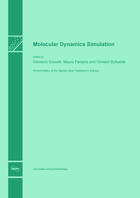Molecular Dynamics Simulation
A special issue of Entropy (ISSN 1099-4300).
Deadline for manuscript submissions: closed (30 September 2013) | Viewed by 213711
Special Issue Editors
Interests: methods in molecular dynamics simulation of systems of statistical mechanical interest; equilibrium and non equilibrium molecular dynamics; rare events; computer simulation of complex molecular systems
Special Issues, Collections and Topics in MDPI journals
Interests: molecular dynamics simulation of condensed matter systems; solvation in h-bonded liquids; friction at the nanoscale; non equilibrium molecular dynamics; free energy computation in solution phase; simulation of tribological phenomena; transport properties in molecular fluids
Special Issues, Collections and Topics in MDPI journals
Interests: rare events statistics in molecular dynamics; coarse graining in molecular dynamics; conformation dynamics
Special Issues, Collections and Topics in MDPI journals
Special Issue Information
Manuscript Submission Information
Manuscripts should be submitted online at www.mdpi.com by registering and logging in to this website. Once you are registered, click here to go to the submission form. Manuscripts can be submitted until the deadline. All submissions that pass pre-check are peer-reviewed. Accepted papers will be published continuously in the journal (as soon as accepted) and will be listed together on the special issue website. Research articles, review articles as well as short communications are invited. For planned papers, a title and short abstract (about 100 words) can be sent to the Editorial Office for announcement on this website.
Submitted manuscripts should not have been published previously, nor be under consideration for publication elsewhere (except conference proceedings papers). All manuscripts are thoroughly refereed through a single-blind peer-review process. A guide for authors and other relevant information for submission of manuscripts is available on the Instructions for Authors page. Entropy is an international peer-reviewed open access monthly journal published by MDPI.
Please visit the Instructions for Authors page before submitting a manuscript. The Article Processing Charge (APC) for publication in this open access journal is 2600 CHF (Swiss Francs). Submitted papers should be well formatted and use good English. Authors may use MDPI's English editing service prior to publication or during author revisions.








